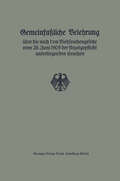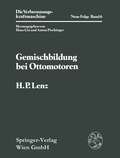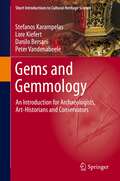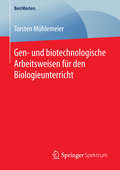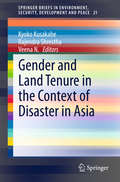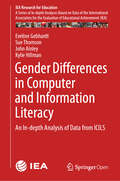- Table View
- List View
Gemeinfaßliche Belehrung über die nach dem Viehseuchengesetze vom 26. Juni 1909 der Anzeigepflicht unterliegenden Seuchen
by ReichsveterinäramtDieser Buchtitel ist Teil des Digitalisierungsprojekts Springer Book Archives mit Publikationen, die seit den Anfängen des Verlags von 1842 erschienen sind. Der Verlag stellt mit diesem Archiv Quellen für die historische wie auch die disziplingeschichtliche Forschung zur Verfügung, die jeweils im historischen Kontext betrachtet werden müssen. Dieser Titel erschien in der Zeit vor 1945 und wird daher in seiner zeittypischen politisch-ideologischen Ausrichtung vom Verlag nicht beworben.
Gemeinwohlorientierte Erzeugung von Lebensmitteln: Impulse für eine zukunftsfähige Agrar- und Ernährungswirtschaft
by Albert SundrumLebensmittel sind Mittel zum Leben. Die Art und Weise ihrer Erzeugung betrifft uns alle. Weitgehend unbemerkt von der öffentlichen Wahrnehmung hat sich in den vergangenen Jahrzehnten ein System der Agrar- und Ernährungsindustrie entwickelt, das uns mit einer Fülle von Nahrungsmitteln mit zu niedrigen Preisen versorgt.Die unerwünschten Nebenwirkungen und externen Kosten dieses Systems wurden jedoch lange Zeit ausgeblendet. Enorme Umwelt- und Klimabelastungen, Verlust der Biodiversität, tierschutzrelevante Missstände und ein anhaltendes Hofsterben beschreiben nur unzulänglich das wahre Ausmaß an Schadwirkungen. Im Interesse des Gemeinwohls können diese nicht länger hingenommen werden. Allerdings stehen die Komplexität der Sachverhalte und vielfältige Partikularinteressen einfachen Lösungen entgegen.Dieses Fachbuch liefert eine umfassende systemische Analyse aus sehr unterschiedlichen Perspektiven und erläutert, wie es zu dieser Entwicklung hat kommen können. Es wird aufgezeigt, welche grundlegenden Veränderungen in allen Bereichen erforderlich sind, um über eine evidenzbasierte Qualitätserzeugung einen Ausweg aus dem zerstörerischen Streben nach Kostenminimierung zu finden. Fachkräfte der Agrar- und Ernährungsindustrie und der involvierten wissenschaftlichen Fachdisziplinen, einschließlich der Veterinärmedizin, sowie Entscheidungsträger in politischen Institutionen, Berufsverbänden und NGOs können dieses Wissen für eine zukunftsfähige Neugestaltung des Lebensmittelsektors nutzen.
Gemini 4: An Astronaut Steps Into The Void (Springer Praxis Books)
by David J. ShaylerThe flight of Gemini 4 in June 1965 was conducted barely four years after the first Americans flew in space. It was a bold step by NASA to accomplish the first American spacewalk and to extend the U.S. flight duration record to four days. This would be double the experience gained from the six Mercury missions combined.This daring mission was the first to be directed from the new Mission Control at the Manned Spacecraft Center near Houston, Texas. It also revealed that: Working outside the spacecraft would require further study.Developing the techniques to rendezvous with another object in space would not be as straightforward as NASA had hoped.Living in a small spacecraft for several days was a challenging but necessary step in the quest for even longer flights.Despite the risks, the gamble that astronauts Jim McDivitt and Ed White undertook paid off. Gemini 4 gave NASA the confidence to attempt an even longer flight the next time. That next mission would simulate the planned eight-day duration of an Apollo lunar voyage. Its story is recounted in the next title in this series: Gemini 5: Eight Days in Space or Bust.
Gemini 5: Eight Days in Space or Bust (Springer Praxis Books)
by David J. ShaylerThis third book of the Gemini mission series focuses on the flight that simulated in Earth orbit the duration of an eight-day Apollo mission to the Moon. After the proof-of-concept test flights Gemini 1, 2 and 3 (as described in GEMINI FLIES!) and the success of the first American EVA as well as the four-day U.S. mission (GEMINI 4), NASA gained the confidence to gradually increase mission time spent in orbit. This is the first known book to focus solely on the Gemini 5 mission and its challenges with equipment failures and difficult living conditions. The mission was targeted to double the endurance of the previous one, and as such was an integral stepping stone for an even more audacious mission four months later. Attempting the eight- and then fourteen-day durations would be an opportunity for America to gain the lead in space exploration over the Soviets. This mission pioneered the duration of a flight to the Moon and back three years before Apollo 8 made that journey, without a lunar landing, for the first time.
Gemini Flies!: Unmanned Flights and the First Manned Mission (Springer Praxis Books)
by David J. ShaylerIn May 1961, President John F. Kennedy committed the United States to landing a man on the moon before the end of the decade. With just a handful of years to pull it off, NASA authorized the Project Gemini space program, which gathered vital knowledge needed to achieve the nation’s goal. This book introduces the crucial three-step test program employed by the Gemini system, covering: The short unmanned orbital flight of Gemini 1 that tested the compatibility of launch vehicle, spacecraft and ground systems. The unmanned suborbital flight of Gemini 2 to establish the integrity of the reentry system and protective heat shield. The three-orbit manned evaluation flight of Gemini 3, christened ‘Molly Brown’ by her crew. A mission recalled orbit by orbit, using mission transcripts, post-flight reports and the astronauts’ own account of their historic journey.The missions of Project Gemini was the pivotal steppingstone between Project Mercury and the Apollo Program. Following the success of its first two unmanned missions and the exploits of Gus Grissom and John Young on Gemini 3, NASA gained the confidence to plan an even bolder step on its next mission, as described in the next book in this series on Gemini 4.
Geminoid Studies: Science and Technologies for Humanlike Teleoperated Androids
by Hiroshi Ishiguro Fabio Dalla LiberaThis book describes the teleoperated android Geminoid, which has a very humanlike appearance, movements, and perceptions, requiring unique developmental techniques. The book facilitates understanding of the framework of android science and how to use it in real human societies. Creating body parts of soft material by molding an existing person using a shape-memory form provides not only the humanlike texture of the body surface but also safe physical interaction, that is, humanlike interpersonal interaction between people and the android. The teleoperation also highlights novel effects in telecommunication. Operators of the Geminoid feel the robot's body as their own, and people encountering the teleoperated Geminoid perceive the robot's body as being possessed by the operator as well.Where does the feeling of human presence come from? Can we transfer or reproduce human presence by technology? Geminoid may help to answer these questions.
Gemischbildung bei Ottomotoren (Die Verbrennungskraftmaschine. Neue Folge #6)
by Hans P. LenzSeit das Werk von K. Löhner und K. Müller, "Gemischbildung und Verbrennung im Ottomotor" 1967 erschienen ist, sind 23 Jahre vergangen. Verständlicherweise haben sich in dieser Zeit viele neue Erkenntnisse ergeben, so daß es dringend an der Zeit erschien, diesen neuen Wissensstand nunmehr zusammengefaßt vorzulegen. Den Schwerpunkt des Bandes stellt die Gemischbildung für Ottomotoren dar, sowohl bezüglich der Grundlagen als auch hinsichtlich der Ausführung der Gemischbildner, d.h. der Einspritzsysteme und der Vergaser sowie der zugehörigen Saugrohre. Ebenso wird auf die dazugehörige Meßtechnik eingegangen. Die Grundlagen der Verbrennung werden in dem Umfang erläutert, als sie zum Verständnis der Auswirkung der Gemischbildung erforderlich sind. Das Buch soll sowohl dem in Forschung und Praxis tätigen Ingenieur als auch Studierenden und sonstigen Fachleuten, die sich auf diesem Gebiet vertiefen wollen, einen Überblick über den Stand des Wissens und der Technik geben. Auch nach mehr als 100jähriger Entwicklung im Motorenbau wird gerade auf diesem Gebiet heute weltweit intensive Forschung betrieben; große Fortschritte sind zu verzeichnen. 400 Literaturquellen aus aller Welt wurden berücksichtigt.
Gemischbildung und Verbrennung im Dieselmotor (Die Verbrennungskraftmaschine #7)
by Anton Pischinger Otto CordierDieser Buchtitel ist Teil des Digitalisierungsprojekts Springer Book Archives mit Publikationen, die seit den Anfängen des Verlags von 1842 erschienen sind. Der Verlag stellt mit diesem Archiv Quellen für die historische wie auch die disziplingeschichtliche Forschung zur Verfügung, die jeweils im historischen Kontext betrachtet werden müssen. Dieser Titel erschien in der Zeit vor 1945 und wird daher in seiner zeittypischen politisch-ideologischen Ausrichtung vom Verlag nicht beworben.
Gemischbildung und Verbrennung im Ottomotor (Die Verbrennungskraftmaschine #6)
by Kurt Löhner Herbert MüllerGemischbildungs-, Selbstzündungs- und Verbrennungsvorgänge im Hinblick auf die Vorgänge bei Gasturbinenbrennkammern: aus dem Institut für Wärmetechnik und Verbrennungsmotoren der Rhein.-Westf. Technischen Hochschule Aachen (Forschungsberichte des Wirtschafts- und Verkehrsministeriums Nordrhein-Westfalen #483)
by Werner ZimmerGems and Gemmology: An Introduction for Archaeologists, Art-Historians and Conservators (Short Introductions to Cultural Heritage Science)
by Peter Vandenabeele Stefanos Karampelas Lore Kiefert Danilo BersaniThis book provides a lucid introduction to the basics of gemmology. It familiarizes archaeologists, art historians and conservators with the science of gemstones and allows them to understand the basic concepts of their provenance, typology and treatments.Which are the main types of gems? What treatments can be applied? How does one analyse gems? How can gems contribute to archaeometrical research?This volume is written by four experts in the fields of gemmology and archaeometry and addresses both students who need an introduction to this field and professionals who want to refresh their knowledge of the topic. This work is part of a series of introductory texts that deal with a broad range of materials-related topics in archaeometry.
Gen- und biotechnologische Arbeitsweisen für den Biologieunterricht (BestMasters)
by Torsten MühlemeierTorsten Mühlemeier hat es sich zum Ziel gemacht, einen Überblick über den bestehenden Gentechnikunterricht an allgemeinbildenden Schulen zu gewähren. Dem Autor gelingt es, ausgewählte gen- und biotechnische Arbeitsweisen so zu schematisieren, dass diese im Biologieunterricht durchführbar sind. Neben den aufgeführten Protokollen werden Ergebnisse aktueller biologiedidaktischer Forschung zum Thema Gentechnik aufgeführt und Möglichkeiten aufgezeigt, die gentechnische Versuche mit Schulklassen ermöglichen.
Genaulagen-Synthese von ebenen Koppelgetrieben mit aufgabenspezifisch konzipierten Bearbeitungsstrategien: Theoretische Grundlagen und praktische Umsetzung
by Reinhard BrauneDas vorliegende Buch ist konzipiert als umfassende Monografie zur so genannten Genaulagen-Synthese von Koppelgetrieben aus der persönlichen Sicht des Autors, gestützt auf dessen über 40-jährige Forschungsarbeit und praktische Erfahrung in diesem Themenfeld. Es wird aufgezeigt, wie mit heutigen Mitteln der rechnerunterstützten Anwendung neu interpretierte Ansätze derGenaulagen-Synthese optimal zur effektiven Maß-Synthese in interaktiven Auslegungsprozessen genutzt werden können und welche software-technischen Voraussetzungen dazu erforderlich sind, aber auch an welche Grenzen man dabei stößt. Einen Kernpunkt bildet das vom Autor und seinen ehemaligen Mitarbeitern in Hannover entwickelte Konzept der so genannten problemspezifischen Bearbeitungsstrategien.
Gender and Distance Education: Indian and International Contexts
by Anu AnejaThis book investigates the intersection of gender and distance education from a feminist perspective and explores their contemporary innovative interfaces in Indian and international contexts. The key issues raised here include a re- investigation of the democratizing potential of distance education from a gendered perspective (especially in developing countries such as India), feminist pedagogical perspectives on the notion of transactional distance, the relationship between masculinity and gerontology from the perspective of non- traditional modes, and the interrelationships between gender and social media from a distance education perspective. As opposed to the conventional, physical classroom, the virtual classroom often occupies a de- privileged space in feminist pedagogical discussions, since it appears to align itself less easily with feminist praxes which encourage a free, intellectual exchange between teachers and students. By opening up various facets of the relationship between gender, distance education and feminist pedagogy, the book foregrounds the critical need to re- visit preconceived, unfavourable assumptions about this relationship and proposes mutually productive inter-linkages. It does so in the context of contemporary circumstances defined by the increasing use of virtual technology, the ongoing need for democratization of higher education and the constraints posed by consumerist trends. Lucid and topical, this Focus volume will be useful to scholars and researchers of higher education, open and distance education, feminist pedagogy, gender studies, feminism, masculinity, and women’s studies as well as practitioners and policymakers working in the education sector.
Gender and Distance Education: Indian and International Contexts
by Anu AnejaThis book investigates the intersection of gender and distance education from a feminist perspective and explores their contemporary innovative interfaces in Indian and international contexts. The key issues raised here include a re- investigation of the democratizing potential of distance education from a gendered perspective (especially in developing countries such as India), feminist pedagogical perspectives on the notion of transactional distance, the relationship between masculinity and gerontology from the perspective of non- traditional modes, and the interrelationships between gender and social media from a distance education perspective. As opposed to the conventional, physical classroom, the virtual classroom often occupies a de- privileged space in feminist pedagogical discussions, since it appears to align itself less easily with feminist praxes which encourage a free, intellectual exchange between teachers and students. By opening up various facets of the relationship between gender, distance education and feminist pedagogy, the book foregrounds the critical need to re- visit preconceived, unfavourable assumptions about this relationship and proposes mutually productive inter-linkages. It does so in the context of contemporary circumstances defined by the increasing use of virtual technology, the ongoing need for democratization of higher education and the constraints posed by consumerist trends. Lucid and topical, this Focus volume will be useful to scholars and researchers of higher education, open and distance education, feminist pedagogy, gender studies, feminism, masculinity, and women’s studies as well as practitioners and policymakers working in the education sector.
Gender and Early Television: Mapping Women’s Role in Emerging US and British Media, 1850-1950 (Library of Gender and Popular Culture)
by Sarah ArnoldBetween the nineteenth century and the mid-twentieth century television transformed from an idea to an institution. In Gender and Early Television, Sarah Arnold traces women's relationship to the new medium of television across this period in the UK and USA. She argues that women played a crucial role in its development both as producers and as audiences long before the 'golden age' of television in the 1950s.Beginning with the emergence of media entertainment in the mid-nineteenth century and culminating in the rise of the post-war television industries, Arnold claims that, all along the way, women had a stake in television. As keen consumers of media, women also helped promote television to the public by performing as 'television girls'. Women worked as directors, producers, technical crew and announcers. It seemed that television was open to women. However, as Arnold shows, the increasing professionalisation of television resulted in the segregation of roles. Production became the sphere of men and consumption the sphere of women. While this binary has largely informed women's role in television, through her analysis, Arnold argues that it has not always been the case.
Gender and Early Television: Mapping Women’s Role in Emerging US and British Media, 1850-1950 (Library of Gender and Popular Culture)
by Sarah ArnoldBetween the nineteenth century and the mid-twentieth century television transformed from an idea to an institution. In Gender and Early Television, Sarah Arnold traces women's relationship to the new medium of television across this period in the UK and USA. She argues that women played a crucial role in its development both as producers and as audiences long before the 'golden age' of television in the 1950s.Beginning with the emergence of media entertainment in the mid-nineteenth century and culminating in the rise of the post-war television industries, Arnold claims that, all along the way, women had a stake in television. As keen consumers of media, women also helped promote television to the public by performing as 'television girls'. Women worked as directors, producers, technical crew and announcers. It seemed that television was open to women. However, as Arnold shows, the increasing professionalisation of television resulted in the segregation of roles. Production became the sphere of men and consumption the sphere of women. While this binary has largely informed women's role in television, through her analysis, Arnold argues that it has not always been the case.
Gender and Land Tenure in the Context of Disaster in Asia (SpringerBriefs in Environment, Security, Development and Peace #21)
by Kyoko Kusakabe Rajendra Shrestha Veena N.This book explores an interdisciplinary field at the intersection of gender and development studies, disaster and land tenure policy. It is well known that women generally have weaker claims to land. But how does that translate to increased vulnerability during disaster? Using case studies from Asia, this book argues that land tenure is a key factor in mitigating the impact of disasters on women. The scale and frequency of disasters have been increasing in recent decades due to human impact on the landscape and climate. Unsustainable farming and land management systems have increased environmental risks and social vulnerabilities. However, around the world the costs of disasters are disproportionately borne by women, due largely to their reduced mobility and lack of control over assets. In post-disaster settings, women’s vulnerabilities increase due to gendered rescue and rehabilitation practices. As such, a gendered approach to land rights is critical to disaster preparedness and recovery.
Gender and Rural Globalization: International Perspectives on Gender and Rural Development
by Monika Agarwal Margaret Alston Berit Brandth Angela Calvo Megan Canning Anne Cassidy Francesca Alice Centrone Majda Cernic Istenic Chrysanthi Charatsari Jessica Duncan Elisabeth Garner Donatella Greco Wendy Harcourt Marit S. Haugen Susie Jacobs Lori Ann McVay Ilona Matysiak Peter Mollinga Janet Momsen Angela Mosso Caoimhe Ni Dhonaill Nargiza Nizamedinkhodjayeva Mark Riley Carolyn Sachs Heather Sangster Sally Shortall Susanne Stenbacka Margreet van der Burg Chiara ZanettiThis book explores how rural gender relations are changing in a globalising world that fundamentally impacts on the structure of agricultural life in rural areas and urban-rural relations. It analyses the development of rural gender relations in specific places around the world and looks into the effects of the increasing connectivity and mobility of people across places. The themes covered are: gender and mobility, gender and agriculture, Gender and rural politics, rurality and Gender identity and women and international development. Each theme has an overview of the state of the art in that specific thematic area and integrates the case-studies that follow.
Gender Aspects of Climate Change and Sustainable Development: A Global Overview (Science for Sustainable Societies)
by Isabel B. Franco Syeda Umama Mehreen Anuska JoshiThis book addresses how sustainability discourse and advocacy can translate to impactful policies especially when bridging the divide between sustainability, climate change and gender. The book explores various areas, such as conservation, climate action, sustainable fashion, and corporate sustainability, and defines the existing sustainability gaps in the selected cases (country/sector/region). It highlights the value of sustainability science and climate change on innovative approaches to research, education, capacity-building, and practice to transform rhetoric into impact sustainability while encompassing cases from various industries, sectors, and geographical contexts. While emphasizing SDG 5, the book chapters also show the transboundary implications of gender equality and inclusivity to other sustainable development and climate change goals and targets. The contributions are exemplary in highlighting the relation of gender inclusivity in strengthening efforts to protect andsafeguard the world’s cultural and natural heritage and making cities and human settlements inclusive and safe (Goal 11), protecting, restoring, and promoting sustainable management of terrestrial ecosystems and reverse land degradation (Goal 15), ensuring access to affordable, reliable, sustainable and modern energy for all (Goal 7), promoting sustainable and inclusive economic growth with productive and decent employment for all (Goal 8), promoting inclusive and sustainable industrialization (Goal 9), adopt policies to reduce inequalities (Goal 10), ensure sustainable consumption and production pattern (Goal 12), addressing climate change impacts and building resilience (Goal 13), and ensuring availability and sustainable management of water and sanitation for all (Goal 6).
Gender Differences in Computer and Information Literacy: An In-depth Analysis of Data from ICILS (IEA Research for Education #8)
by Eveline Gebhardt Sue Thomson John Ainley Kylie HillmanThis open access book presents a systematic investigation into internationally comparable data gathered in ICILS 2013. It identifies differences in female and male students’ use of, perceptions about, and proficiency in using computer technologies. Teachers’ use of computers, and their perceptions regarding the benefits of computer use in education, are also analyzed by gender. When computer technology was first introduced in schools, there was a prevailing belief that information and communication technologies were ‘boys’ toys’; boys were assumed to have more positive attitudes toward using computer technologies. As computer technologies have become more established throughout societies, gender gaps in students’ computer and information literacy appear to be closing, although studies into gender differences remain sparse. The IEA’s International Computer and Information Literacy Study (ICILS) is designed to discover how well students are prepared for study, work, and life in the digital age. Despite popular beliefs, a critical finding of ICILS 2013 was that internationally girls tended to score more highly than boys, so why are girls still not entering technology-based careers to the same extent as boys? Readers will learn how male and female students differ in their computer literacy (both general and specialized) and use of computer technology, and how the perceptions held about those technologies vary by gender.
Gender in Agriculture: Closing the Knowledge Gap
by Agnes R. Quisumbing Ruth Meinzen-Dick Terri L. Raney André Croppenstedt Julia A. Behrman Amber PetermanThe Food and Agriculture Organization of the United Nations (FAO) produced a 2011 report on women in agriculture with a clear and urgent message: agriculture underperforms because half of all farmers—women—lack equal access to the resources and opportunities they need to be more productive. This book builds on the report’s conclusions by providing, for a non-specialist audience, a compendium of what we know now about gender gaps in agriculture.
Gender in Music Production (Perspectives on Music Production)
by Russ Hepworth-Sawyer Jay Hodgson Liesl King Mark MarringtonThe field of music production has for many years been regarded as male-dominated. Despite growing acknowledgement of this fact, and some evidence of diversification, it is clear that gender representation on the whole remains quite unbalanced. Gender in Music Production brings together industry leaders, practitioners, and academics to present and analyze the situation of gender within the wider context of music production as well as to propose potential directions for the future of the field. This much-anticipated volume explores a wide range of topics, covering historical and contextual perspectives on women in the industry, interviews, case studies, individual position pieces, as well as informed analysis of current challenges and opportunities for change. Ground-breaking in its synthesis of perspectives, Gender in Music Production offers a broadly considered and thought-provoking resource for professionals, students, and researchers working in the field of music production today.
Gender in Music Production (Perspectives on Music Production)
by Jay Hodgson Russ Hepworth-Sawyer Mark Marrington Liesl KingThe field of music production has for many years been regarded as male-dominated. Despite growing acknowledgement of this fact, and some evidence of diversification, it is clear that gender representation on the whole remains quite unbalanced. Gender in Music Production brings together industry leaders, practitioners, and academics to present and analyze the situation of gender within the wider context of music production as well as to propose potential directions for the future of the field. This much-anticipated volume explores a wide range of topics, covering historical and contextual perspectives on women in the industry, interviews, case studies, individual position pieces, as well as informed analysis of current challenges and opportunities for change. Ground-breaking in its synthesis of perspectives, Gender in Music Production offers a broadly considered and thought-provoking resource for professionals, students, and researchers working in the field of music production today.
Gender Integration in NATO Military Forces: Cross-national Analysis (Gender in a Global/Local World)
by Lana ObradovicNumerous states have passed gender integration legislation permanently admitting women into their military forces. As a result, states have dramatically increased women’s numbers, and improved gender equality by removing a number of restrictions. Yet despite changes and initiatives on both domestic and international levels to integrate gender perspectives into the military, not all states have improved to the same extent. Some have successfully promoted gender integration in the ranks by erasing all forms of discrimination, but others continue to impede it by setting limitations on equal access to careers, combat, and ranks. Why do states abandon their policies of exclusion and promote gender integration in a way that women’s military participation becomes an integral part of military force? By examining twenty-four NATO member states, this book argues that civilian policymakers and military leadership no longer surrender to parochial gendered division of the roles, but rather support integration to meet the recruitment numbers due to military modernization, professionalization and technological advancements. Moreover, it proposes that increased pressure by the United Nations to integrate gender into security and NATO seeking standardization and consistency on the international level, and women’s movements on the domestic level, are contributing to greater gender integration in the military.
